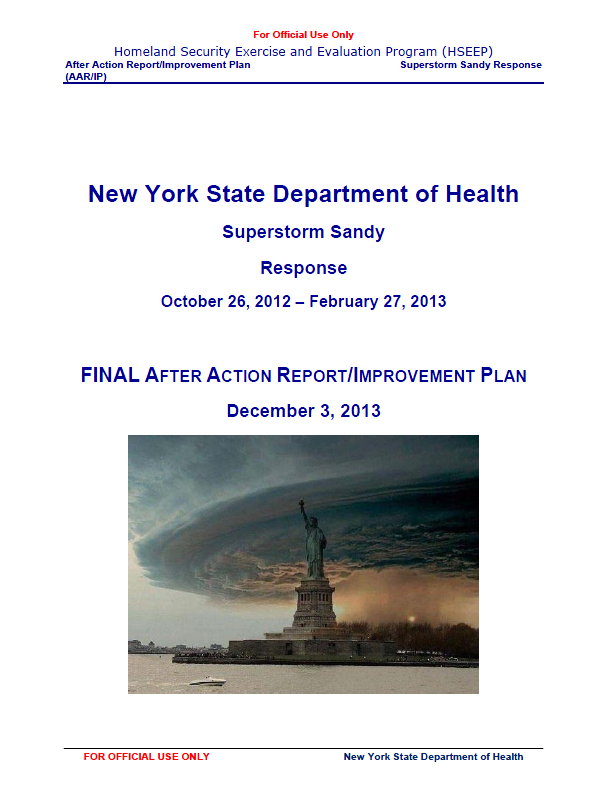New York State Department of Health Superstorm Sandy Response October 26, 2012 – February 27, 2013
- 104 pages
- For Official Use Only
- December 3, 2013
Superstorm Sandy, a late-season post-tropical cyclone and the tenth storm of the 2012 Atlantic hurricane season, swept through the Caribbean and up the East Coast of the United States in late October 2012. The storm left 42 dead in New York State (NYS), thousands homeless and millions without power. Superstorm Sandy began as a tropical wave in the Caribbean on October 19, 2012. It quickly developed into a tropical depression and then a tropical storm in six hours. It quickly moved north, then turned northwest within the next week, making landfall on October 29, 2012 striking near Atlantic City, New Jersey with winds of 80 miles per hour. At one point, Superstorm Sandy’s hurricane force winds (74 mph) extended up to 175 miles from its center and tropical storm force winds (39 mph) out to 485 miles. A full moon made high tides 20 percent higher than normal, amplifying Superstorm Sandy’s storm surge.
Superstorm Sandy’s strength and angle of approach combined to produce a record storm surge of water into New York City. The surge level at Battery Park topped 13.88 feet by 9:25 p.m. that same evening and the New York Harbor’s surf reached a record level with 32.5 foot waves.
Seawater poured over Lower Manhattan’s seawalls and highways into low-lying streets. The water inundated tunnels, subway stations and the electrical system powering Wall Street. Thousands of hospital patients, nursing home and adult care residents were evacuated. The storm shut down five acute care hospitals, one psychiatric hospital and 26 residential-care facilities (nursing homes and adult care facilities). More than 7,800 patients and residents were evacuated through efforts coordinated by the New York State Department of Health (NYSDOH) Healthcare Facility Evacuation Center (HEC). Other healthcare facilities and services also suffered the storm’s effects: 300 buildings housing doctors’ offices, 100 retail pharmacies and at least 70 outpatient and ambulatory care centers sustained significant flooding (5%) and power outages (12%).
The NYSDOH activated its Incident Management System (IMS) on October 26, as well as the Health Operations Center (HOC), the HEC and provided staff to the New York City Emergency Operations Center (EOC) and the New York State EOC. The response efforts by the NYSDOH ended 125 days later on February 27, 2013, second in duration only to the response period for the 2009 H1N1 influenza pandemic.
The NYSDOH response efforts to this significant late season storm in October 2012 tested a number of Target Capabilities, including: 1) Citizen Evacuation and Shelter-in-Place, 2) Environmental Health, 3) Volunteer Management and Donation, 4) Medical Materiel Management and Distribution, 5) Onsite Incident Management, 6) Mass Care, 7) Epidemiological Surveillance and Investigation, 8) Emergency Triage and Pre-Hospital Treatment (Emergency Management System (EMS)), 9) Planning and 10) Community Preparedness.
…
Primary Areas for Improvement
Throughout the operation several opportunities for improvement in the NYSDOH’s ability to respond to the incident were identified. The primary areas for improvement are as follows:
- Although communication was often cited as a strength, communication among response partners to include healthcare facilities, the HEC and the NYSDOH can always be improved.
- Develop formalized tools and protocols for Shelter-in-Place (SIP), including staff availability, adequate infrastructure and available resources.
- Develop policies for NYSDOH regarding overtime, use of personal cars and equipment and meal reimbursement.
- Review and train additional staff on the ICS.
- Delineation of NYSDOH and NYCDOHMH roles and responsibilities within the HEC.
- Develop centralized coordination and notification protocols for bed placement.
- Develop a formalized process to match patient needs with resources and bed availability.
- A patient tracking system is a critical need.
- Delineate sheltering planning and operational roles for NYSDOH.
- Develop an approval process and required information for HERDS surveys with a specific timeframe.
- Develop pre-planned guidance for regulatory waivers.
- Consider making the Statewide EMS Mobilization Plan statutory.
- Develop a more efficient system of tracking ambulances and EMS resources during deployments.

